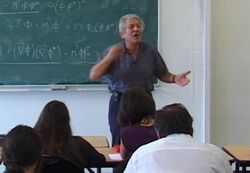Biography:Jean Iliopoulos
Jean Iliopoulos (born in 1940 in Kalamata) is a French-Greek physicist.[1]
Biography
Graduated from the Polytechnic School of Athens in 1962, he specializes in high energy theoretical physics and particle physics. He is one of the pioneers of supersymmetry (c.f. Fayet-Iliopoulos term).
In 1987, he received the prestigious JJ Sakurai Award.
He was one of the founders, at the École normale supérieure, of the Laboratory of Theoretical Physics (LPTENS), which he directed from 1991 to 1995 and from 1998 to 2002.
Jean Iliopoulos has been a member of the French Academy of Sciences since 2002.[2]
In 2007, he won the Dirac Award for his prediction (with Sheldon Glashow and Luciano Maiani) of charming quark.
Scientific work
Jean Iliopoulos is a specialist in high energy theoretical physics and elementary particle physics. In 1970, in collaboration with S.L. Glashow and L. Maïani, he introduced the so-called "GIM" mechanism (named after the three authors) which is an essential element of the theory of fundamental interactions known as the "Standard Model ".[3] This mechanism postulates the existence of a new elementary particle, the "charmed" quark, a prediction that was confirmed by experience. In 1972, in collaboration with Claude Bouchiat and Philippe Meyer,[4] he demonstrated that the mathematical coherence of the Standard Model requires symmetry between the elementary constituents of matter, namely quarks (which form hadrons such as proton and neutron) and leptons (such as electron, muon and neutrinos). This symmetry is also verified experimentally.
Jean Iliopoulos was one of the pioneers of supersymetry, the hypothetical symmetry that links fermions and bosons. He showed that it has remarkable convergence properties and, in collaboration with P. Fayet,[5] he proposed a mechanism that leads to its spontaneous breakage. He also studied some aspects of the quantum theory of gravitation as well as the mathematical properties of invariant gauge theories formulated in a non-commutative geometric space.
Most significant publications
- Glashow, S. L.; Iliopoulos, J.; Maiani, L. (1970-10-01). "Weak Interactions with Lepton-Hadron Symmetry". Physical Review D (American Physical Society (APS)) 2 (7): 1285–1292. doi:10.1103/physrevd.2.1285. ISSN 0556-2821.
- Bouchiat, C.; Iliopoulos, J.; Meyer, Ph. (1972). "An anomaly-free version of Weinberg's model". Physics Letters B (Elsevier BV) 38 (7): 519–523. doi:10.1016/0370-2693(72)90532-1. ISSN 0370-2693.
- Iliopoulos, J.; Zumino, B. (1974). "Broken supergauge symmetry and renormalization". Nuclear Physics B (Elsevier BV) 76 (2): 310–332. doi:10.1016/0550-3213(74)90388-5. ISSN 0550-3213. http://cds.cern.ch/record/415096.
- Fayet, P.; Iliopoulos, J. (1974). "Spontaneously broken supergauge symmetries and goldstone spinors". Physics Letters B (Elsevier BV) 51 (5): 461–464. doi:10.1016/0370-2693(74)90310-4. ISSN 0370-2693.
- Antoniadis, I.; Iliopoulos, J.; Tomaras, T. N. (1986-03-31). "Quantum Instability of de Sitter Space". Physical Review Letters (American Physical Society (APS)) 56 (13): 1319–1322. doi:10.1103/physrevlett.56.1319. ISSN 0031-9007. PMID 10032637.
- Floratos, E.G.; Iliopoulos, J.; Tomaras, T.N. (1987). "Tree-level scattering amplitudes in de Sitter space diverge". Physics Letters B (Elsevier BV) 197 (3): 373–378. doi:10.1016/0370-2693(87)90403-5. ISSN 0370-2693.
- Floratos, E.G.; Iliopoulos, J.; Tiktopoulos, G. (1989). "A note on SU(∞) classical Yang-Mills theories". Physics Letters B (Elsevier BV) 217 (3): 285–288. doi:10.1016/0370-2693(89)90867-8. ISSN 0370-2693. http://cds.cern.ch/record/192677.
- Floratos, E.G.; Iliopoulos, J. (2006). "Gauge theories and non-commutative geometry". Physics Letters B (Elsevier BV) 632 (4): 566–570. doi:10.1016/j.physletb.2005.10.081. ISSN 0370-2693.
- J. Iliopoulos, Aux origines de la masse, EDP Sciences (2015)
- L. Baulieu, J. Iliopoulos, R. Sénéor, From Classical to Quantum Fields, Oxford University Press (2017)
Honours and Awards
- Paul Langevin Prize, French Physical Society (1978)
- Grand Prix Jean Ricard, French Physical Society (1984)
- J.J. Sakurai Prize, American Physical Society (1986)
- Member of the French Academy of Sciences[2]
- Bodossaki Grand Prix (Greece, 2002)
- Matteucci Medal, Accademia Nazionale delle Scienze, Italy (2006)
- Dirac Medal, ICTP (2007)
- High Energy Physics Prize, European Physical Society (2011)
- Prize of the Three Physicists, ENS (2013)
- Honorary Doctorate from the Universities of Crete (1999), Ioannina (2002), Athens (2002), Patras (2004), Athens Polytechnic School (2017).
References
- ↑ « Jean Iliopoulos » dans Élémentaire, numéro 6, page 10
- ↑ 2.0 2.1 Jean Iliopoulos, physicien des particules - Médaillé Dirac 2007, 8 aout 2007
- ↑ Glashow, S. L.; Iliopoulos, J.; Maiani, L. (1970-10-01). "Weak Interactions with Lepton-Hadron Symmetry". Physical Review D (American Physical Society (APS)) 2 (7): 1285–1292. doi:10.1103/physrevd.2.1285. ISSN 0556-2821.
- ↑ Bouchiat, C.; Iliopoulos, J.; Meyer, Ph. (1972). "An anomaly-free version of Weinberg's model". Physics Letters B (Elsevier BV) 38 (7): 519–523. doi:10.1016/0370-2693(72)90532-1. ISSN 0370-2693.
- ↑ Fayet, P.; Iliopoulos, J. (1974). "Spontaneously broken supergauge symmetries and goldstone spinors". Physics Letters B (Elsevier BV) 51 (5): 461–464. doi:10.1016/0370-2693(74)90310-4. ISSN 0370-2693.


